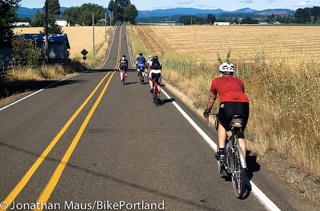
27 miles of rural roads this summer.
(Photo J. Maus/BikePortland)
Washington County road crews are gearing up for several major chip seal projects that will impact popular rural roads during the peak summer riding season.
For the county, chip seal is a way to extend the life of road surface and save them money in repairs and maintenance in the long-run; but to people who love riding on smooth roads, it means more bumps due to the tiny little rocks (chips) that are laid down in the process. The projects also mean that the roads will be closed briefly during and immediately after the work is completed.
Washington County is aware of these issues and they mention bicycling and offer this explanation of the chip seal process on their website:
Bicyclists may want to avoid roads during and immediately after chip sealing. During the chip seal process, the road surface is covered with an emulsified asphalt and small rocks (chips). A roller presses the chips into the emulsion, and the surface is swept several times to remove most of the loose material. To reduce the amount of loose chips even more, a polymerized (stickier) asphalt is used. The process is completed with a fog seal, which is a thin film of liquid asphalt and sand. The fog seal fills small voids, providing a smoother surface.
We recognize that this road work causes some short-term inconvenience. Please keep in mind that the result is a long-term benefit to all road users, including bicyclists.
Here’s a map we made showing some of the popular routes on the chip seal list:
And here’s the complete list:
- Aten Road from Pleasant Valley to dead end (west)
- Hillside Road from Kansas City to Clapshaw Hill
- Kemper Road from Hwy 47 to Kansas City
- Old Cornelius Pass Road from Cornelius Pass to Multnomah county line
- Pleasant Valley Road from Scholls Ferry to end of pavement
- Pumpkin Ridge Road from Shadybrook to end of pavement (Murphy)
- Spring Hill Road from Yamhill county line to Hwy 47
- West Union Road from Helvetia to Glencoe
- Woolen Road from Sellers to Green Mountain
The work is expected to last through August. If you plan to ride in these areas, your best bet is to check WC-Roads.com for the latest project updates or call (503) 846-ROAD (7623) before you head out.
For more about how chip seal impacts bicycling, read this 2011 blog post from Kent Peterson.

